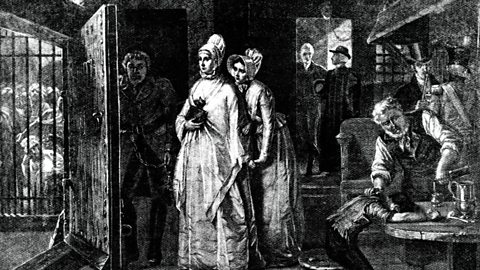The use of prisons to punish and reform in the 19th century
Attitudes to prisons before the 19th century
Prisons were rarely used in the 16th and 17th centuries as they were not seen to provide retribution or deterrence. They were used to hold people before trial and before their capital or corporal punishment was carried out. Conditions in these prisons, or gaols, were poor.
Houses of correction were used in Tudor times and were sometimes called bridewell House of correction вҖ“ a type of prison.. Their aim was to reformTo make changes to something or someone, for improvement. persistent beggars, and provide 'correction' for unmarried mothers. There were also debtors' prisons where those in debt remained until their debts were repaid.
In the period between the end of transportation to America (1776) and the start of transportation to Australia (1787), the prisons became full. They even began to use hulkA disused warship that was used as a temporary prison. as prisons. Living conditions inside these hulks were dreadful, with around a quarter of prisoners dying per year from disease or violence.
18th century prisons were poor and many people began to suggest that prisons should be reformed. In 1777, John Howard published a report on prison conditions called The State of the Prisons in England and Wales. His main observations were:
- prisoners were not separated by gender or type of crime
- many prisoners were dying of illness and disease
- jailers, or gaolers, were often corrupt
- too few people were employed to make the prisons secure and safe
- many prisoners stayed in prison beyond the end of their sentence as they could not afford the jailers fees to be released
Howard recommended that prisoners should be kept in solitary confinement to prevent the spread of negative influences, and to give them time to reflect on their wrongdoing. He believed prisons could be places that reform criminals. His research and opinion were influential in bringing about a change in attitudes towards the function of prisons.
Other prison reformers also began demanding changes to prisons to make them more secure and hygienic. G O Paul designed a new prison that was based on four key principles - security, health, separation and reform. It had separate areas for male and female prisoners, as well as a chapel, workrooms and exercise yards.
19th century attitudes to prisons
The pressure for reform of prisons continued through Elizabeth Fry. She campaigned for better conditions for female prisoners at Newgate Prison and spent time teaching inmates skills.
She convinced many people at the time that the current prison conditions were inhumane and uncivilised. This struck a chord with early Victorian society and her campaign helped change attitudes towards the role of prisons and the rights of those held within them. Elizabeth Fry also campaigned for the rights and welfare of prisoners who were being transported.

1823 Gaols Act
The pressure from the reformers led to the Gaols Act which stated that:
- prisons should be made secure
- jailers should be paid
- female prisoners should be kept separately from male prisoners
- doctors and chaplains should visit prisons
- attempts should be made to reform prisoners
Prison reformers promoted the belief that prisons should be designed and run to reform prisoners which became the dominant attitude in the 19th century. It was believed that prisoners could be reformed through hard work, reflection and Christian teaching inside prisons. Increasingly prisons were viewed as places where people could be reformed.